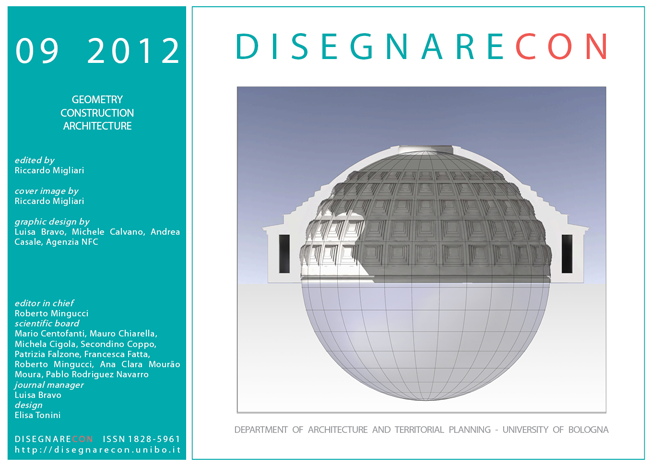The splines age: geometries and lines of contemporary design
DOI:
https://doi.org/10.6092/issn.1828-5961/3182Keywords:
splines, NURBS, freeforms, architectural geometry, digital representationAbstract
Architecture and design have always been characterized by lines and geometric forms made possible by new materials and by building technology evolution, as well as by the new mathematical tools for digital design representation. It is the case of the splines, lines on which are based the NURBS (Non Uniform Rational B-Splines) and the freeforms became the symbol of the most advanced contemporary architecture and design. Beginning from the analysis of the geometry and the representation of this particular curves, this paper discusses the role of splines and NURBS on contemporary architectural design that has to deal with the mathematical and geometrical models from which their building depends.
References
Clough R. W. (1960), The finite element method in plane stress analysis, Proc. 2nd A.S.C.E.Conf: on Electronic Comp., Pittsburgh, PA.
Cottrell J.A., Hughes T.J.R. e Bazilevs Y. (2009), Isogeometric Analysis: Toward Integration of CAD and FEA, Wiley.
Farin, Gerald (1999), NURB curves and surfaces: from projective geometry to practical use, AK Peters, Natic.
Huerta, Santiago (2006), Structural Design in the Work of Gaudì, in Architectural Science Review, Vol. 49.4, pp. 324-339Hughes T. J. R., Cottrell J. A. e Bazilevs Y., Isogeometric analysis: CAD, finite elements, NURNS, exact geometry and mesh refinement, Comput. Methods Appl. Mech. Engrg., n.194, 2005.
Hughes T. J. R., Cottrell J. A. e Bazilevs Y. (2005), Isogeometric analysis: CAD, finite elements, NURBS, exact geometry and mesh refinement, Comput. Methods Appl. Mech. Engrg., n.194, pp. 4135–4195.
Kim H., Querin O.M., Steven G.P. (2002), On the development of structural optimisation and its relevance in engineering design, in Design Studies, Vol. 23 (1), pp. 85-102.
Kolarevic, Branco (2003), Architecture in the Digital Age: Design and Manufacturing, Taylor & Francis, London.
Leach, Neil; Turnbull, David; Williams, Chris J.K. (2004); Digital Tectonics, Chichester, Wiley.
Menges Achim (2006), Instrumental Geometry, in Architectural Design, Special Issue: Techniques and Technologies in Morphogenetic Design, Vol. 76, (2), pp.42-53.
Mitchell, William J.. (1990), The Logic of Architecture: Design Computation and Cognition, MIT Press, Cambridge.
Oxman, Rivka (2006), Theory and design in the first digital age, in Design Studies, Vol. 27 (3), pp. 229-265.
Piegl, Les; Tiller, Wayne (1966); The NURBS book, Springer-Verlag, New York.
Pottmann, Helmut; Asperl, Andreas; Hofer, Michael; Kilian, Axel (2010); Architekturgeometrie, Springer & Bentley Institute Press.
Pottmann, Helmut (2010), Architectural Geometry as Design Knowledge, in Architectural Design, Special Issue: The New Structuralism: Design, Engineering and Architectural Technologies, Vol. 80 (4), pp 72–77.
Sala, Nicoletta; Sala, Massimo (2005), Geometrie del design. Forme e materiali per il progetto, Angeli, Milano.
Turner M. J., Clough R. W., Martin H. C., Topp L. J. (1956), Stiffness and deflection analysis of complex structures, in Journal of Aeronautical Sciences, vol. 23 (9), pp. 805-824.
Wendland, David (2003), Model-based formfinding processes: 'Free forms' in structural and architectural design, in Levi, Franco; Chiorino, Mario A.; Bertolini Cestari, Clara; Eduardo Torroja – From the philosophy of structure to the art and science of building, Angeli, Milano.
Downloads
Published
How to Cite
Issue
Section
License
Copyright (c) 2012 Enrico Cicalò, Andrea Causin, Margherita Solci, Emilio Turco





